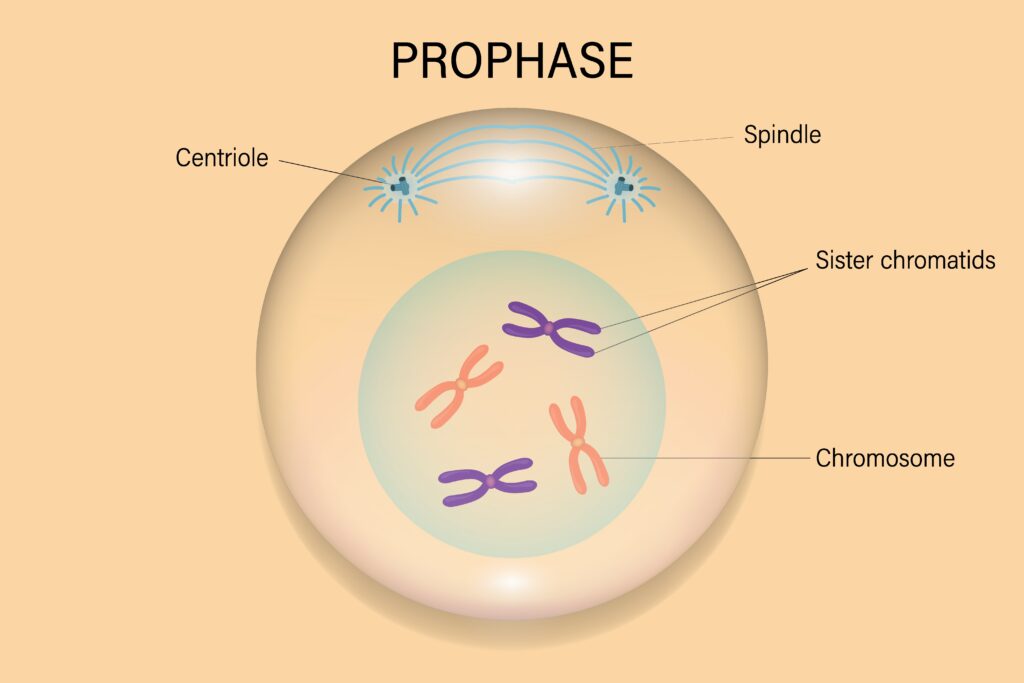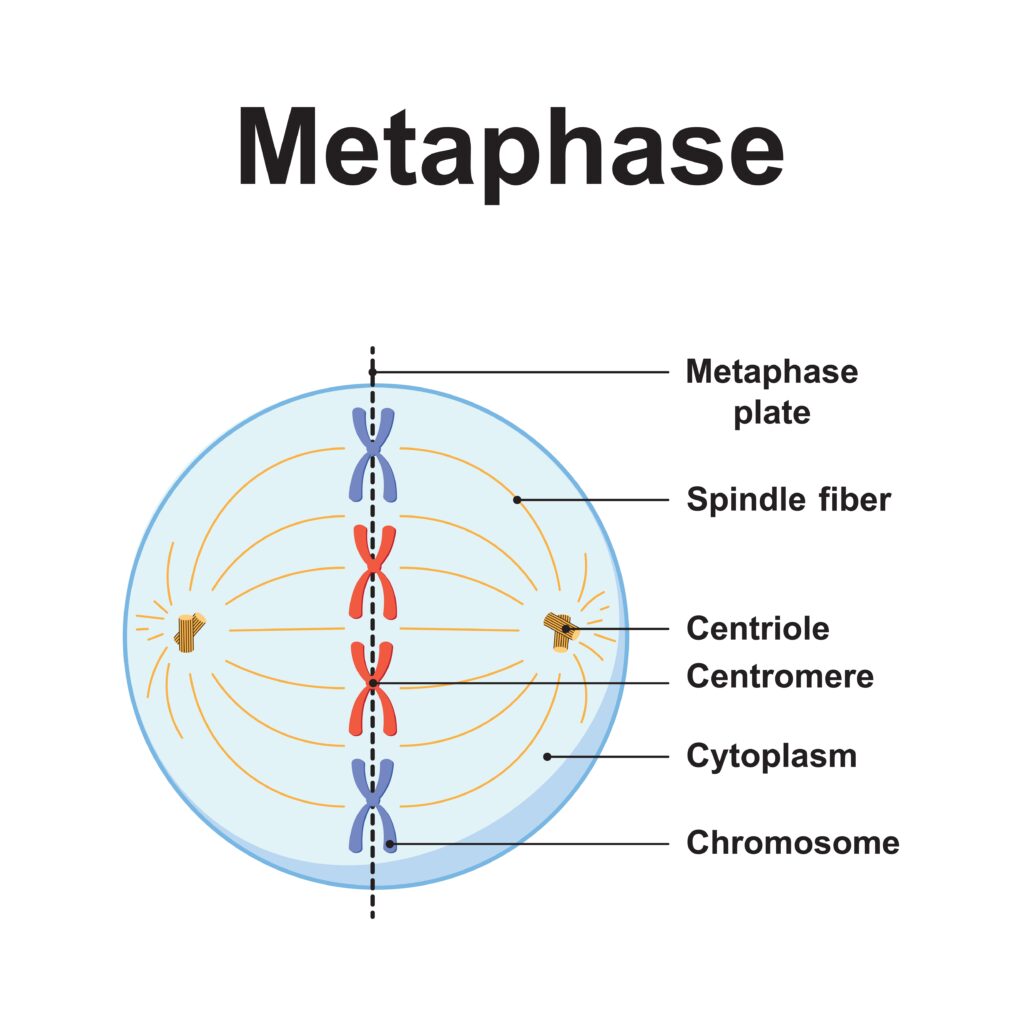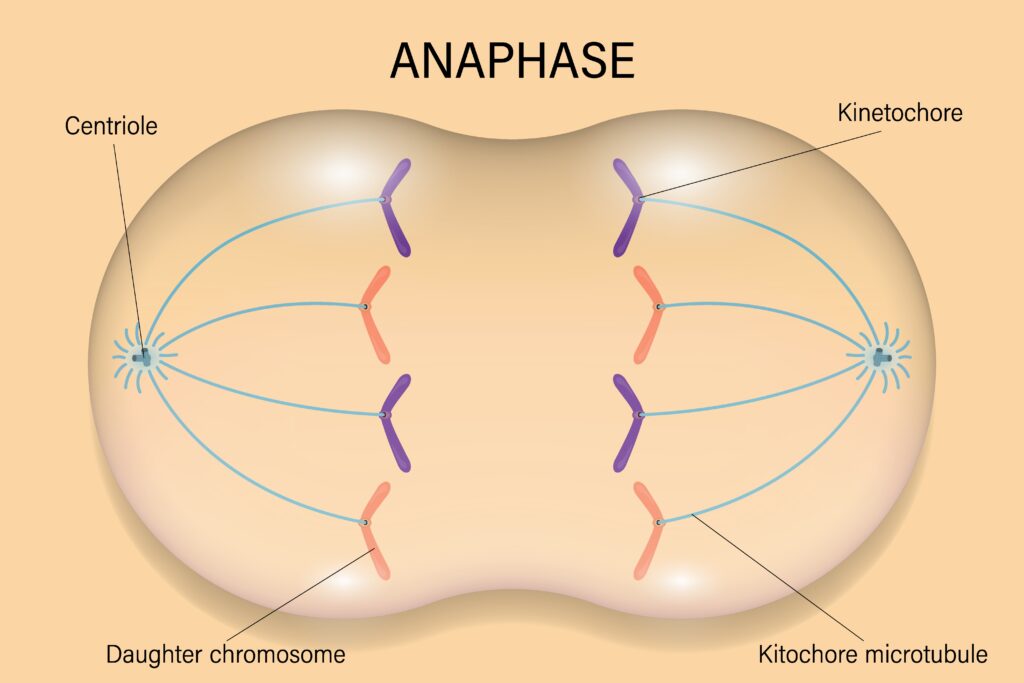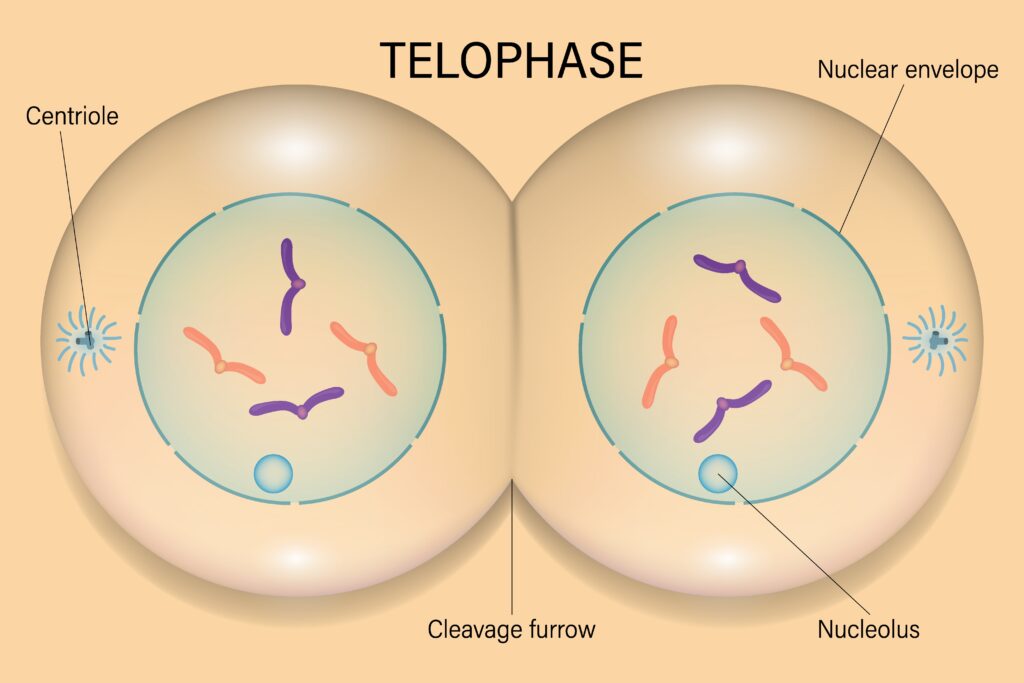By the end of this lesson, you will be able to:
- Explain the purpose of mitosis
- Identify and describe each phase of mitosis
Key Vocabulary
- Mitosis – a cellular division process where one cell divides to produce two identical daughter cells
Mitosis is the process by which a cell divides and produces two identical daughter cells. It is a critical process for growth and repair in multicellular organisms like humans.
The process of mitosis is divided into four stages: prophase, metaphase, anaphase, and telophase.
Let’s look at each of these stages in more detail:
Interphase:
This is the stage of the cell cycle that occurs before mitosis begins. Interphase is important because it is the time when the cell is preparing to divide into two daughter cells. During interphase, the cell increases in size produces additional organelles and proteins, and duplicates all of its DNA. The cell then has two copies of its DNA going into mitosis, which is organized into two sister chromatids as the DNA condenses.
Prophase:
Prophase is the first stage of mitosis, where the cell begins the process of dividing into two daughter cells.

At the beginning of prophase, the chromatin, which is the combination of DNA and proteins, starts to condense. This condensation causes the chromatin to coil and compact, resulting in the formation of distinct structures called chromosomes. Chromosomes are easier to manage and distribute during cell division.
Another process that is happening in prophase is the breakdown of the nuclear envelope. The nucleus of the cell is surrounded by a membrane called the nuclear envelope, which separates the nucleus from the rest of the cell. This breakdown allows the chromosomes to be exposed to the cytoplasm of the cell.
Next is the formation of the mitotic spindle. The mitotic spindle is a structure composed of microtubules that helps in the movement and separation of chromosomes during cell division. In prophase, two centrosomes, which are small organelles located near the nucleus, move to opposite ends of the cell. As the centrosomes move, they generate spindle fibers that extend from each centrosome toward the center of the cell. These spindle fibers form a complex network known as the mitotic spindle.
As the mitotic spindle develops, it interacts with the chromosomes. Specialized protein structures called kinetochores form at the centromere region of each chromosome, which serve as attachment points for the spindle fibers. Then, these spindle fibers attach to the kinetochores and help to align and position the chromosomes in the cell.
Metaphase:
Metaphase is the next stage of mitosis, where the chromosomes line up in the center of the cell as the cell gets ready to divide.
In prophase, the chromosomes began moving towards the center of the cell. During metaphase, spindle fibers continue to exert tension on the chromosomes, aligning them along the metaphase plate in the center of the cell. This alignment ensures that each chromosome is properly positioned for the upcoming separation.

The metaphase plate is an imaginary plane that runs through the center of the cell and is perpendicular to the spindle fibers. The chromosomes line up single-file along this plate. The alignment is essential for ensuring that each daughter cell receives an equal and complete set of chromosomes during cell division. Before moving into anaphase, the cell completes a quick checkpoint to make sure that all the chromosomes are lined up correctly and that all of them are connected to the spindle fibers by their kinetochores.
During metaphase, the chromosomes are at their most condensed and visible state. They appear as distinct structures, with two sister chromatids held together by the centromere.
Anaphase:
In anaphase, the spindle fibers shorten and pull the sister chromatids (the two identical parts of a chromosome) apart towards the opposite poles of the cell.

At the start of anaphase, the connections holding the sister chromatids together, the centromeres, dissolve. This allows the sister chromatids to separate and become individual chromosomes. Each chromosome now consists of a single chromatid.
Once the sister chromatids have separated, they move toward opposite poles of the cell. This movement is facilitated by the shortening of the spindle fibers attached to the chromosomes. As the spindle fibers contract, they pull the chromosomes in the direction of the centrosomes located at opposite ends of the cell. The separated chromosomes move in a V-shaped configuration toward the poles.
As the sister chromatids move towards opposite poles, the spindle fibers not attached to chromosomes elongate. This elongation of the spindle fibers helps to further separate the poles of the cell, widening the distance between them.
While anaphase is primarily focused on the separation and movement of chromosomes, it also marks the beginning of cytokinesis, the division of the cell’s cytoplasm. In animal cells, a contractile ring composed of actin and myosin proteins forms in the center of the cell. The ring contracts, leading to the formation of a cleavage furrow that eventually pinches the cell into two daughter cells.
Telophase:
During telophase, the spindle fibers disappear, and a nuclear envelope reforms around each set of chromosomes. The chromosomes begin to uncoil, and the cell begins to divide, creating two identical daughter cells.

Chromosome arrival: In telophase, the separated chromosomes, which migrated to opposite poles during anaphase, reach their respective poles. At this point, two distinct groups of chromosomes are present, one at each pole of the cell.
As telophase progresses, the chromosomes begin to decondense or uncoil. They transition from their highly condensed state back into their extended form of chromatin. Decondensation allows the genetic material to become accessible for gene expression and other cellular processes.
Telophase is characterized by the reformation of the nuclear envelope around each set of chromosomes. The nuclear envelope is made up of two phospholipid bilayers, and it separates the genetic material from the rest of the cell. The nuclear envelope reforms by the fusion of small vesicles derived from the endoplasmic reticulum, creating two distinct nuclei within the cell.
Within each newly forming nucleus, the nucleolus, which is responsible for producing ribosomes, reappears. The nucleolus is composed of RNA, proteins, and DNA segments, and it plays a vital role in protein synthesis.
Telophase also marks the completion of cytokinesis, the process of dividing the cell’s cytoplasm into two daughter cells. In animal cells, the contractile ring formed during anaphase contracts further, forming a cleavage furrow that pinches the cell in half. In plant cells, a new cell wall begins to form between the two daughter nuclei, which will eventually separate the cell into two distinct cells.
After mitosis, the two daughter cells will continue to grow and carry out their functions, identical to the parent cell that produced them. Mitosis is important because it allows cells to divide and produce new cells for growth and repair, and it also plays a crucial role in asexual reproduction in some organisms.

